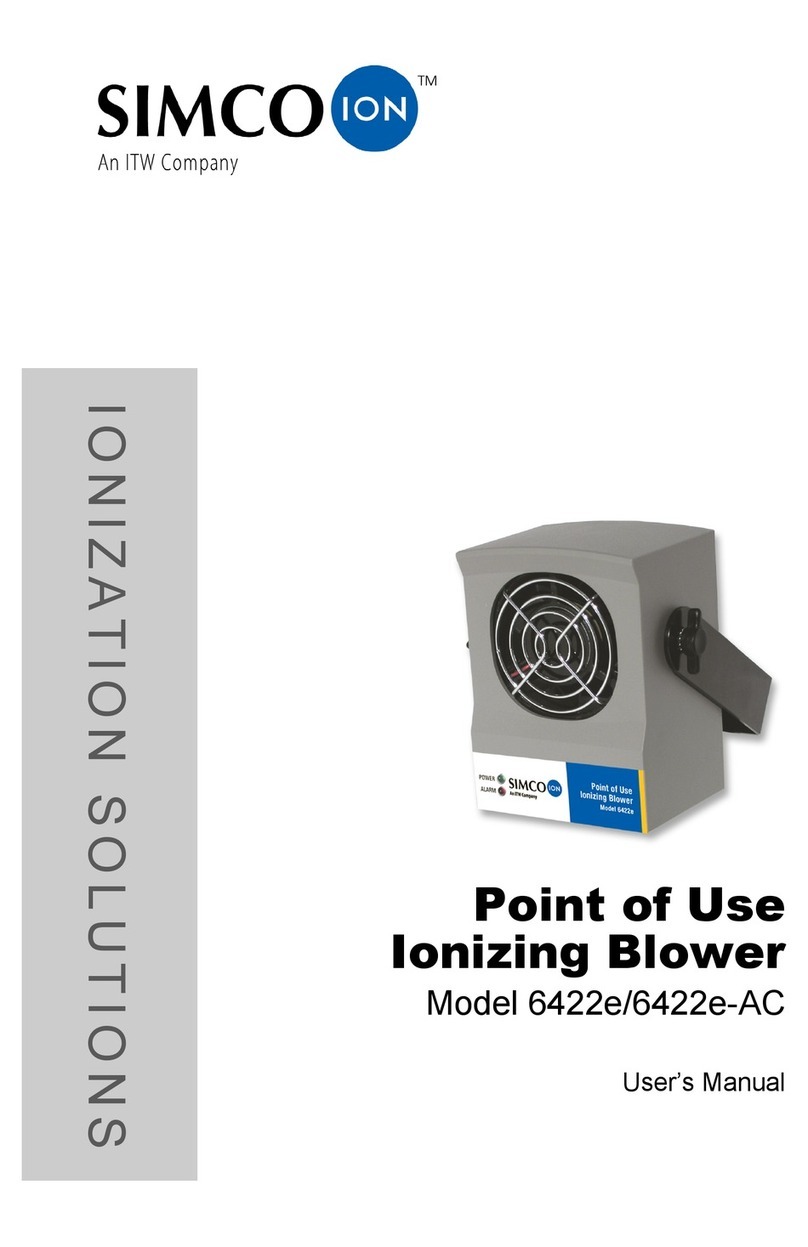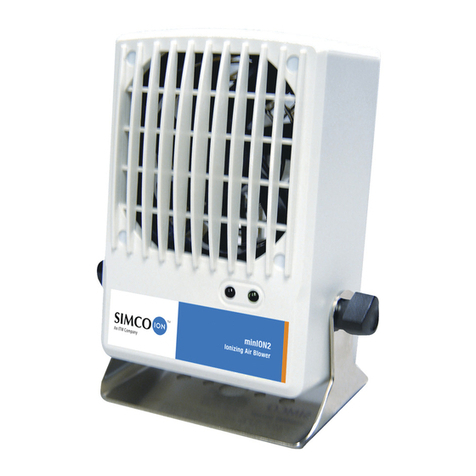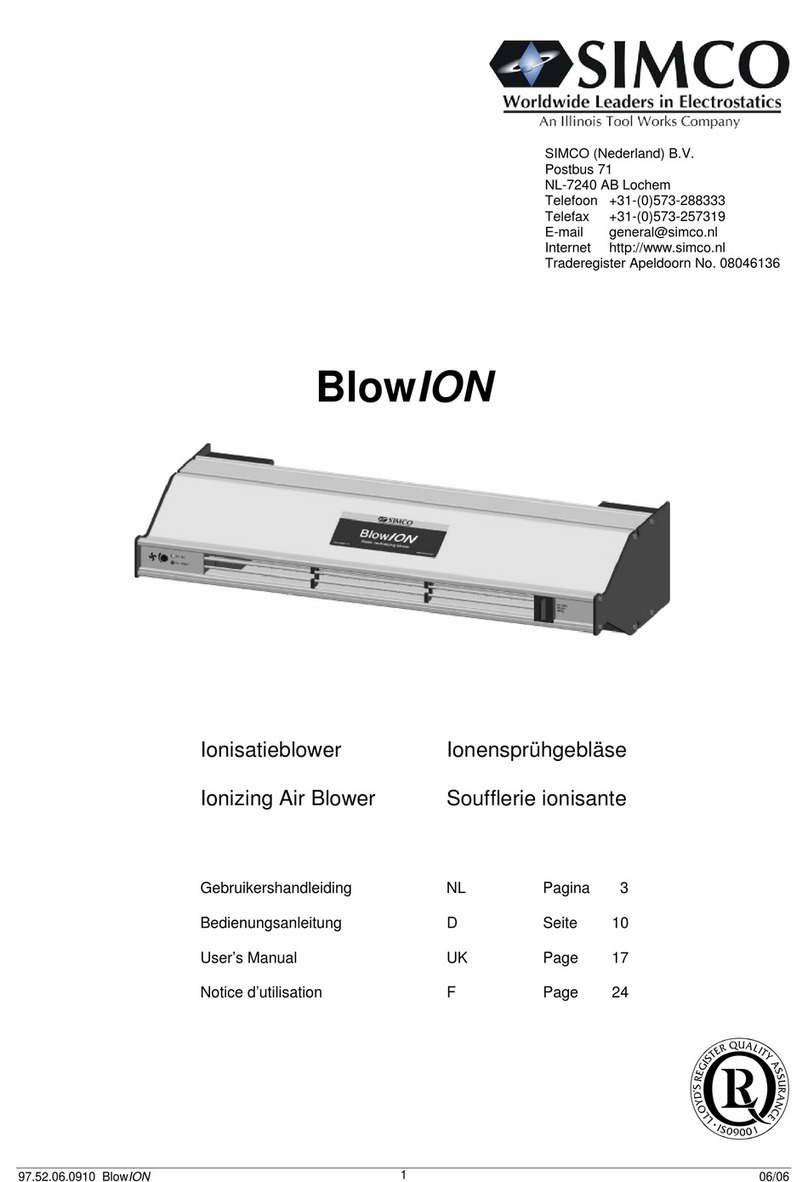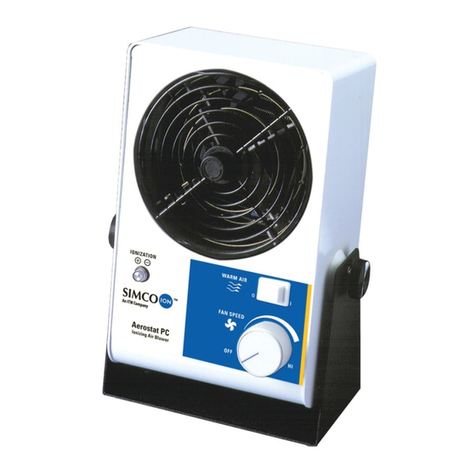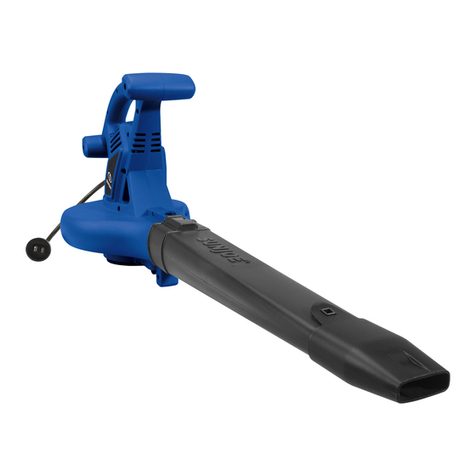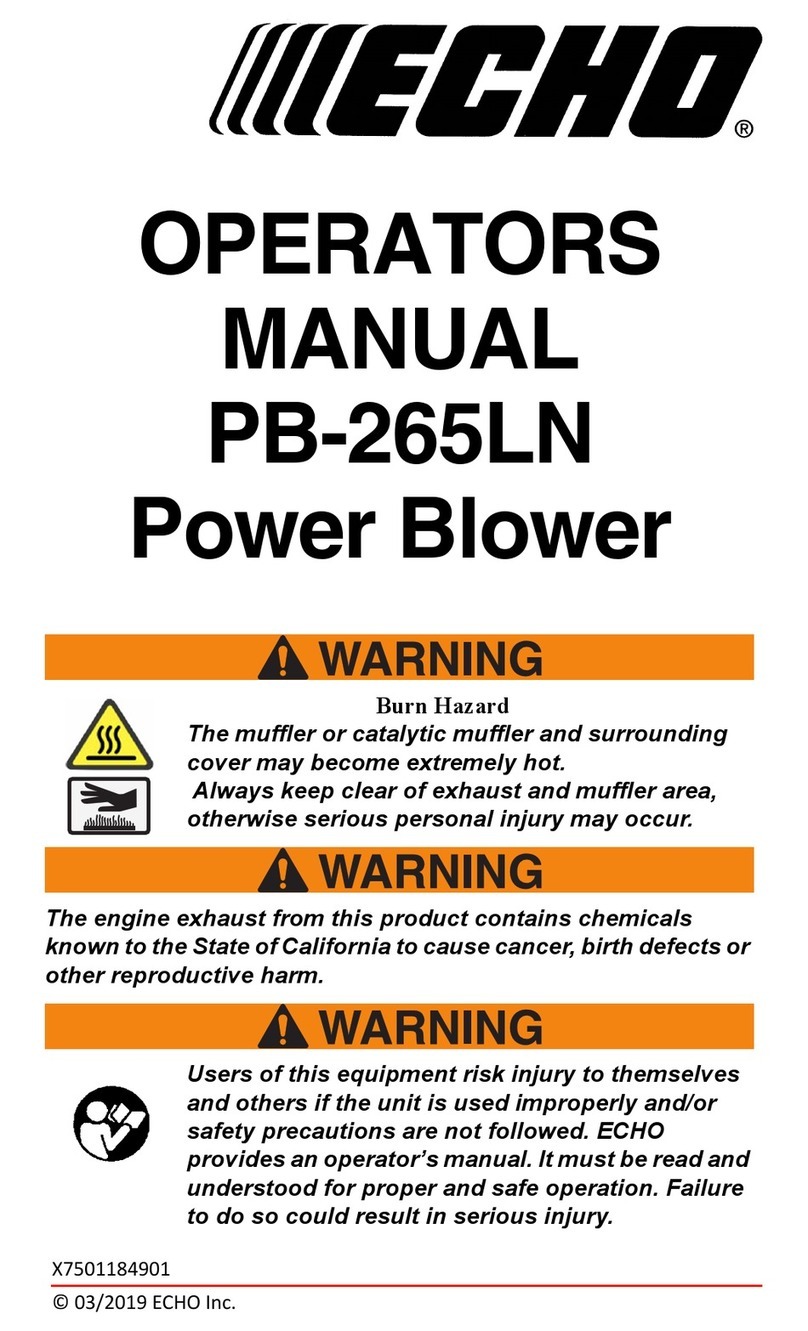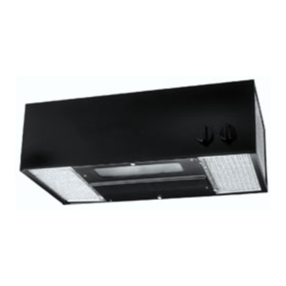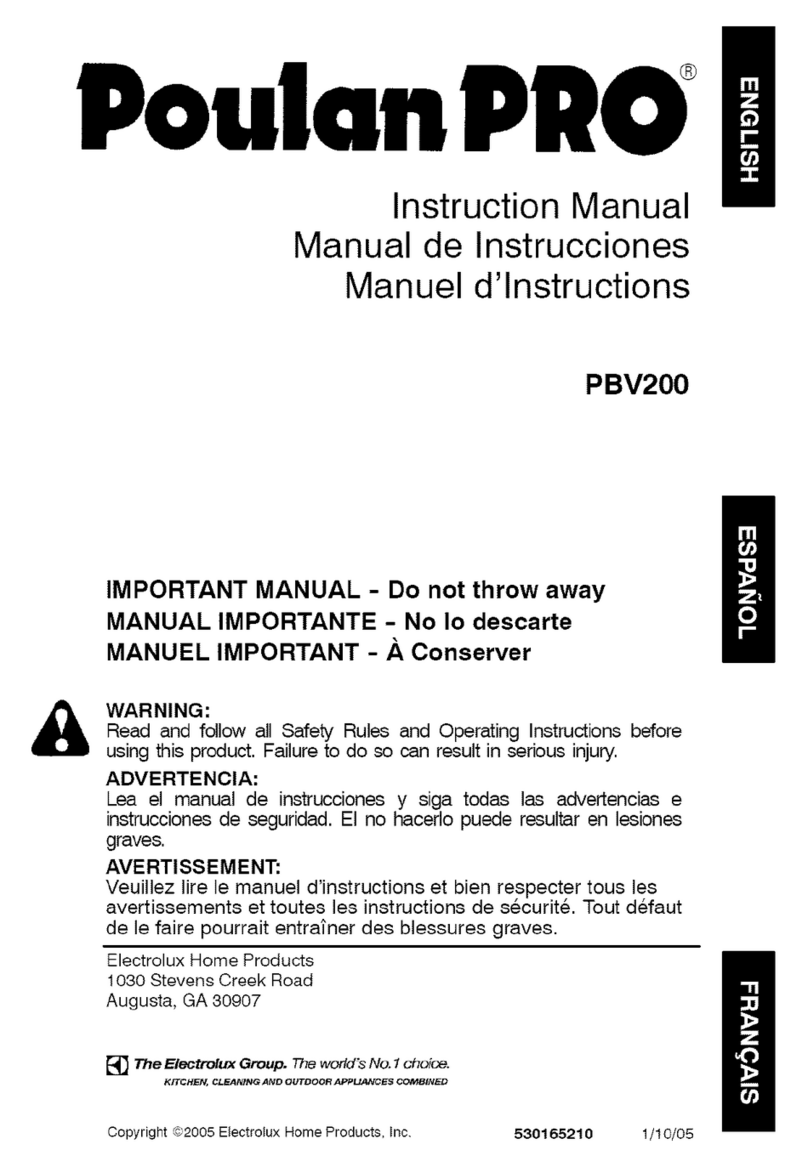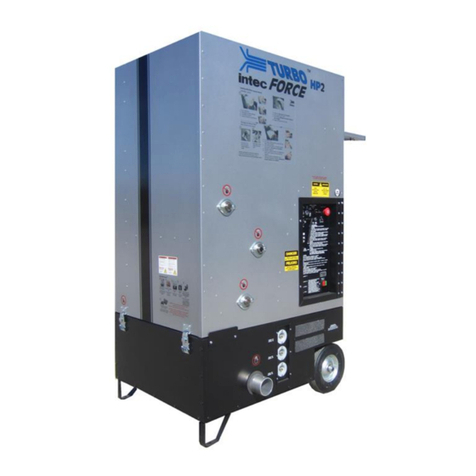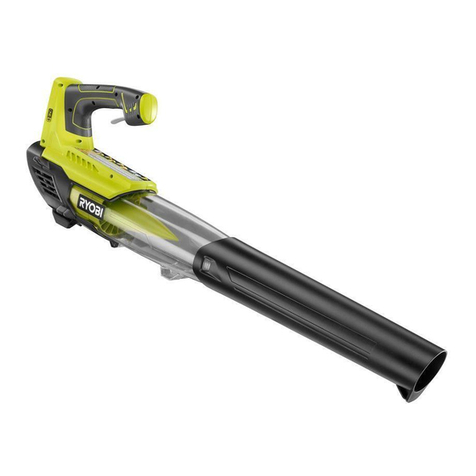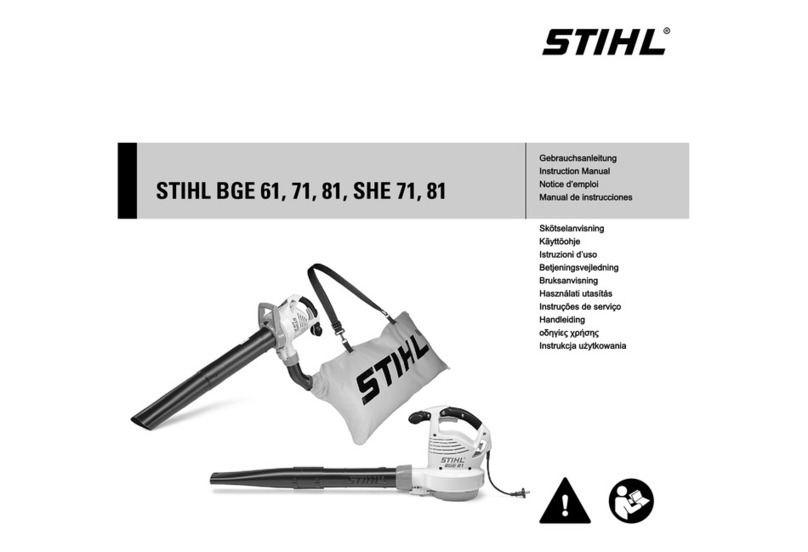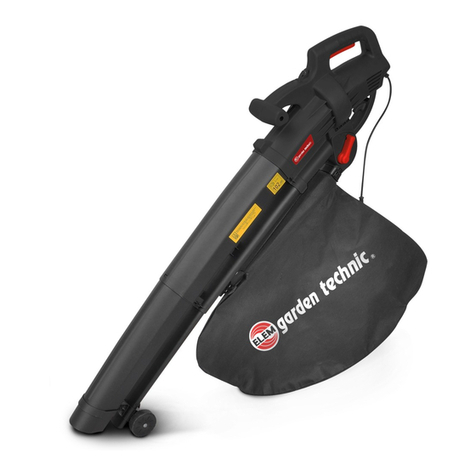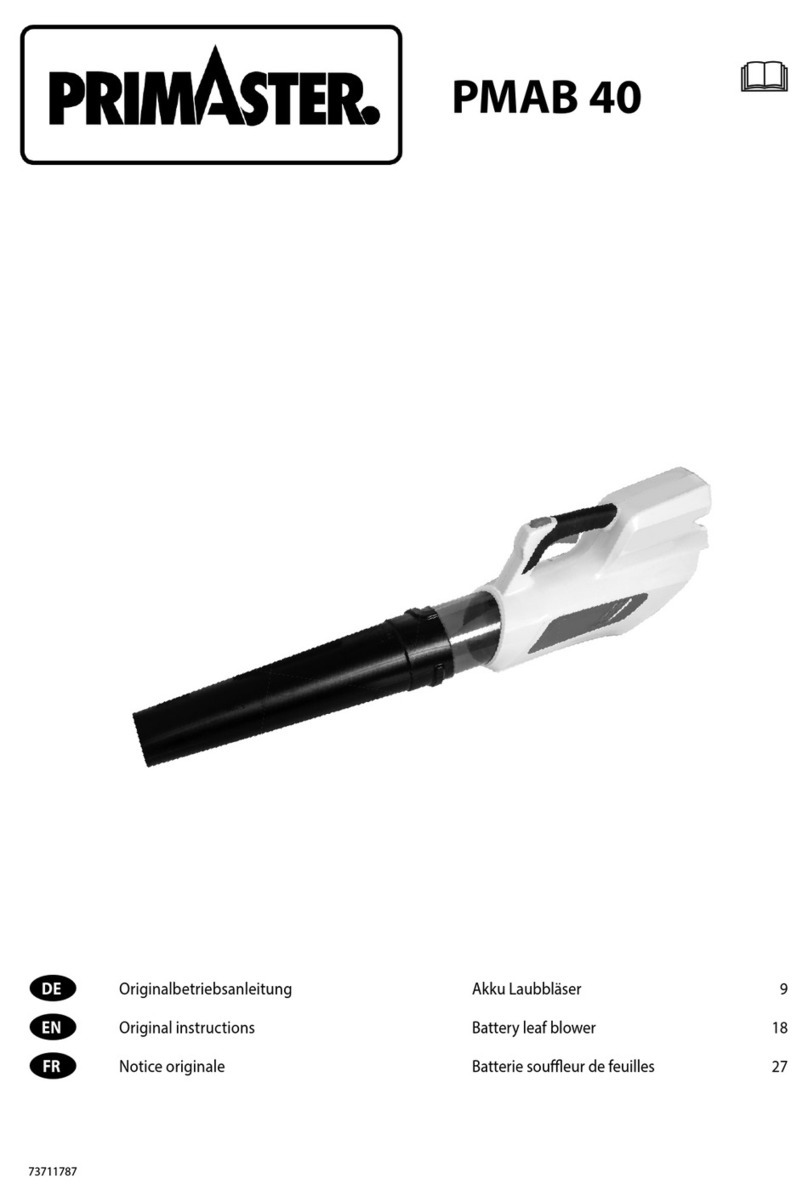Simco AEROSTAT HP-N-Ex User manual

AEROSTAT HP-N-Ex
Bedienungsanleitung DSeite 7
relstatic ag Gublenstrasse 1 CH-8733 Eschenbach
User Manual
Ionizing Air Blower, type:

1. Introduction
2. Safety
3. Use and operation
4. Technical specifications
5. Installation
6. Putting into use
7. Functional check
8. Maintenance
9. Faults
10. Repair
11. Diposal
CONTENTS
Page
8
8
3
3
3
4
5
6
6
7
7
www.relstatic.ch Page 2
Ionizing Air Blower, type: Aerostat HP-N-Ex
12. Spares
8

1. Introduction
Read this manual completely before you install and put this product into use.
This manual is intended as guideline for mounting, installing and maintenance for skilled
technical people. It should be read in combination with the additional manuals supplied
separately for the P-Sh-N-Ex anti static bar and the radial fan (blower).
Follow the instructions set out in these manuals to ensure proper operation of the product and
to be able to invoke guarantee.
The guarantee terms are stated in the General Conditions for the Sale and Delivery of Products
and/or Performance of Activities by Relstatic AG.
2. Safety
- The Simco HP-N-Ex Aerostat®is only intended for neutralizing electro statically charged
parts and/or surfaces.
- When used in potentially explosion hazardous environments: only use the HP-N-Ex
Aerostat®when the zone classification allows to use equipment as classified through the
marking on the 3 labels on the H-P-N-Ex (classification on page 1 only for reference).
Check the conditions for safe use in the ATEX certificate(s).
- Electrical installation shall be performed by a skilled electrical engineer.
- Make sure that the equipment is properly earthed.
Earthing is needed to ensure proper operation and to avoid electrical shocks upon contact.
-No changes, adjustments, etc. are allowed. When changes or no original parts have been
used for repairs,CE approval and Ex classification for the equipment will be withdrawn and
the equipment will no longer be under guarantee.
3. Use and operation
The Simco HP-N-Ex Aerostat®is used to neutralize electro statically charged products and/or
surfaces, also at longer distances (1.5 m max.). The ionizing air blower consists of a motor, a
radial fan and an anti-static bar. The ambient air is drawn on one side and blown off along the
anti-static bar. The power unit is integrated in the anti-static bar.
The blower produces an air flow which is rich on positive and negative ions.
When this air flow is pointed to an electrostatically charged product or surface, electrons will be
exchanged. This causes the product or material to be neutralized. The effective ionizing width
is 380-580 mm.
The HP-N-Ex Aerostat®is suited for use in a potentially explosion hazardous environment,
check that the zone where the equipment is going to be used complies with the equipment class.
Ionizing Air Blower, type: Aerostat HP-N-Ex
www.relstatic.ch Page 3

4. Technical specifications
Fig. 1 Air flow HP-N-Ex
Aerostat®HP-N-Ex
Voltage
Frequency
230/400V
50 Hz
230/400V
60 Hz
254/440V
60 Hz
277/480V
60 Hz
Blower
Voltage /
Current
Δ230 V AC
0.73 A
Δ230 V AC
0.76 A
Δ254 V AC
0.76 A
Δ277 V AC
0.7 A
Υ400 V AC
0.42 A
Υ400 V AC
0.44 A
Υ440 V AC
0.4 A
Υ480 V AC
0.37 A
Power out 90 W90 W90 W90 W
Protection IP 55 IP 55 IP 55 IP 55
Power cable 5m5m5m5m
ATEX category II 2 Gc T4/Ex e II T4 II 2Gc T3/Ex e II T3 II 2Gc T3/Ex e II T3 II 2Gc T3/Ex e II T3
ATEX Certificate PTB02ATEX3114
Anti static bar
Voltage 400 V AC 400 V AC 440 V AC 480 V AC
Current 50 mA 50 mA 50 mA 50 mA
Frequency
Power cable 5m5m5m5m
ATEX category II 2 G Ex smb IIB T4
ATEX Certificate BAS00ATEX2162X
HV signal OK 230 V 10 mA max
System HP-N-Ex
Working distance: 50 - 1500mm
Working Width380 mm – 580mm (See diagram)
Weight: 12.5 kg
Noise level @ 1m 60 dB(A)
Protection IP 40
Ambient temperature 0 - 40°C
Air velocity see diagram
www.relstatic.ch Page 4
Ionizing Air Blower, type: Aerostat HP-N-Ex
50 Hz 60Hz 60Hz 60Hz

5.Installation
5.1. Checks
-Check that the equipment is undamaged and that you have received the correct version.
-Check that the data on the packing slip corresponds with the data shown on the
product received.
-Check that the voltage shown on the rating plates corresponds with the (mains) voltage you are
going to use.
-Check that the equipment may be used in the environment (Ex-zone).
-Check whether there are requirements or instructions in the additional manuals from the attached
ionizing bar, blower and motor.
If you have any problems and/or in the case of ambiguity:
please contact Relstatic AG.
5.2. Installation of the HP-N-Ex Aerostat®
5.2.1. Summary
The air flow from the blower must be in a direction between perpendicular to, and at an angle of
approx. 45° in relation to the material.
For maximum ionization the air flow must cover a surface as large as possible. The air flow
direction must preferably be opposite to the material flow direction. In places where the material
is going to be neutralized, it should have a free layer of air. The blower-neutralizing efficiency
will drop dramatically when it blows along metal parts towards the area to be neutralized, as the
ionizing function will be lost.
The effectiveness of the blower depends on the distance to the material, the air flow and the
material speed. The correct position and airflow direction should be established by experiment.
5.2.2. Mounting
Fit the HP-N-Ex by using the extra mounting holes between the blower and the air guide.
5.2.3. Installation of the HP-N-Ex
Warning:
- Electrical installation shall be carried out by a skilled electrical engineer.
- Earth the Aerostat properly: Earthing is required to ensure proper operation of the
equipment and to avoid unpleasant electrical shocks upon contact.
Earthing is provided through both line cords from blower and anti-static bar.
5.3. Installation of the blower
5.3.1.Summary
Each blower motor must be fitted with a suitable protective motor switch. Adjust this switch to
the rated motor current. The switch must be explosion proof or it must be mounted outside the
explosion hazardous zone.
For additional instructions see the manual from the blower: Operating instructions for
radial fans for use in potentially explosive atmospheres.
www.relstatic.ch Page 5
Ionizing Air Blower, type: Aerostat HP-N-Ex

5.3.2.Connecting the blower
Connections shall be made in conformity with the applicable local regulations and instructions in
this and the additional manual for the radial fan.
5.3.3. Checking the direction of rotation
−Switch the motor briefly on.
−Check the direction of rotation. It must correspond with the direction shown by the arrow.
−If necessary, change the direction of rotation by interchanging 2 phase wires in the
connection.
5.4.Connecting the P-Sh-N-Ex anti-static bar
The anti-static bar must be connected separately (not through the blower). Check for the mains
voltage on the marking from the P-Sh-N-Ex. The connecting line of the anti-static bar should
contain a fuse. A 230 V neon lamp can be fitted as a high-voltage present indicator. Also a relay
can be fitted which triggers an alarm signal if the high voltage fails.
Check for the detailed instructions in the manual supplied with the P-Sh-N-Ex bar.
6. Putting into use
−Switch on the mains voltage from the anti-static bar.
−Switch on the mains voltage from the blower.
7. Functional check
Warning:
−In an explosion-hazardous zone only measuring instruments suited for this zone may
be used.
The neon lamp you fitted (outside the hazardous area) gives an indication of the high voltage.
An electrostatic field meter must be used to measure the efficiency of the anti-static bar.
Measure the charge on the material before and after it has passed the ionising blower.
After passing the blower the charge should be neutralised.
www.relstatic.ch Page 6
Ionizing Air Blower, type: Aerostat HP-N-Ex

8. Maintenance
Warning:
−When carrying out work on the equipment: de-energise the equipment.
−Follow instructions belonging to the Ex zone you are working in.
8.1. General maintenance
−Keep the Aerostat®clean and dry.
−Clean fouled emitter points with a hard non-metallic brush.
Attention:
−Do not damage the emitter points.
9. Faults
9.1. Anti-static bar
Problem Cause Remedy
No/poor ionization Anti-static bar is fouled Clean anti-static bar
Emitter points are covered Remove the cover
Emitter points are damaged Return anti static bar for
repair
No high voltage on emitter
points
No mains voltage on bar Restore mains voltage
Line-side fuse is defective Replace the fuse
Anti-static bar is defective Return anti-static bar for
repair
Table 1 Anti-static bar faults
9.2. Blower
Problem Cause Remedy
Fan does not operate No mains voltage Restore mains voltage
Mains voltage on 2 phase
wires only
Restore mains voltage on
3rd phase wire
Protective motor switch is off Turn on/reset protective
motor switch, check why it
has switched off
Fan operates in wrong
direction
Fan incorrectly connected Interchange connection of 2
phase wires
Fan does not come up to
speed
Mains voltage on 2 phase
wires only
Restore mains voltage on
3rd phase wire
No remedy helps Return complete Aerostat
Table 2 Blower faults
www.relstatic.ch Page 7
Ionizing Air Blower, type: Aerostat HP-N-Ex

10. Repair
Warning:
−When carrying out work on equipment: de-energise the equipment.
−Repairs shall be made by a skilled electrical engineer.
10.1.Replacing the anti-static bar
1. Disconnect the anti-static bar.
2. Dismount the four screws in the profiles from the bar which connects the bar with the
air guide.
3. Dismount the anti-static bar.
4. Mount a new anti-static bar by fitting the four screws through the profile to the air guide.
5. Route and connect the connection lead.
10.2.Replacing the air guide
1. Dismount and remove the Aerostat®.
2. Dismount and remove the anti-static bar.
3. Dismount and remove the air guide from the blower.
4. Mount a new air guide.
5. Fit the anti-static bar.
6. Fit the Aerostat®, using the extra mounting holes between the blower and the air guide.
For other repairs, we advise you to return the HP-N-Ex
Pack the HP-N-Ex properly and clearly state the reason for return.
11. Disposal
Adhere to the applicable local environmental and other rules when disposing of the equipment.
12. Spares
Item No. Pos. Description
1590010000 (1) Anti-static bar P-SH-N-Ex, 400 V 50 Hz HP-N-Ex
1590010010 (1) Anti-static bar P-SH-N-Ex, 400 V 60 Hz HP-N-Ex
1590010710 (1) Anti-static bar P-SH-N-Ex, 440 V 60 Hz HP-N-Ex
1590010810 (1) Anti-static bar P-SH-N-Ex, 480 V 60 Hz HP-N-Ex
3610300000 (2) Air guide
6605314860 (3) Blower 230/400 V 50 Hz 3 ph HP-N-Ex
6605314850 (3) Blower 230/400 V 60 Hz 3 ph HP-N-Ex
6605314900 (3) Blower 440 V 60 Hz 3 ph HP-N-Ex
6605314910 (3) Blower 480 V 60 Hz 3 ph HP-N-Ex
www.relstatic.ch Page 8
Ionizing Air Blower, type: Aerostat HP-N-Ex

(1)
(2) (3)
Fig. 2 Spare parts HP-N-Ex
www.relstatic.ch Page 9
Ionizing Air Blower, type: Aerostat HP-N-Ex

EC Declaration of Conformity
Manufacturer: Simco (Nederland) B.V.
We declare under our sole responsibility that the product as described, is in conformity with the
following standards.
Product description: Ionising Air Blower consisting out of:
Ionising bar P-Sh-N-Ex and blower DNG-47/S
Type HP-N-Ex
Applicable Directives: EC- Low Voltage Directive (2006/95/EC)
EC- Machinery Directive (98/37/EC)
EC- Electromagnetic compatibility (89/336/EEC)
EC- Potential Explosive Atmospheres ATEX (94/9/EC)
Classified Area:
II 2G Ex smb IIB T4 (Bar) 1180
II 2G c T4 / T3 (Blower)
II 2G Ex e II T4 / T3 (Motor) 0102
Notified Body + Certif. nr : Baseefa 1180 BAS00ATEX2162X (blower in var. 4.5)
PTB 0102 PTB02ATEX3114
Used Harmonized Standards: DIN EN 292-1 / DIN-EN292-2: 2000
DIN EN 60204-1: 1998
EN 50081-2: 1993
EN 61000-6-2 2001
EN 60079-0: 2006
DIN EN 60079-10: 1996
EN 60079-18: 2004
DIN EN 1127-1: 1997
DIN EN 13463-1: 2002
DIN EN 13463-5: 2001
DIN EN 14986: 2007
Used National Standards: CSA C22.2 No. 60950-00/UL60950 Third edition
CAN/CSA-C22.2 No. 60950-1-03/UL 60950-1 First edition
SFA 3009: 1985
Place, Date, Signature:
Lochem, 02 March 2009,
Position and name: TS
Q
Mana
g
er
,
B.W. Bel
Table of contents
Other Simco Blower manuals
